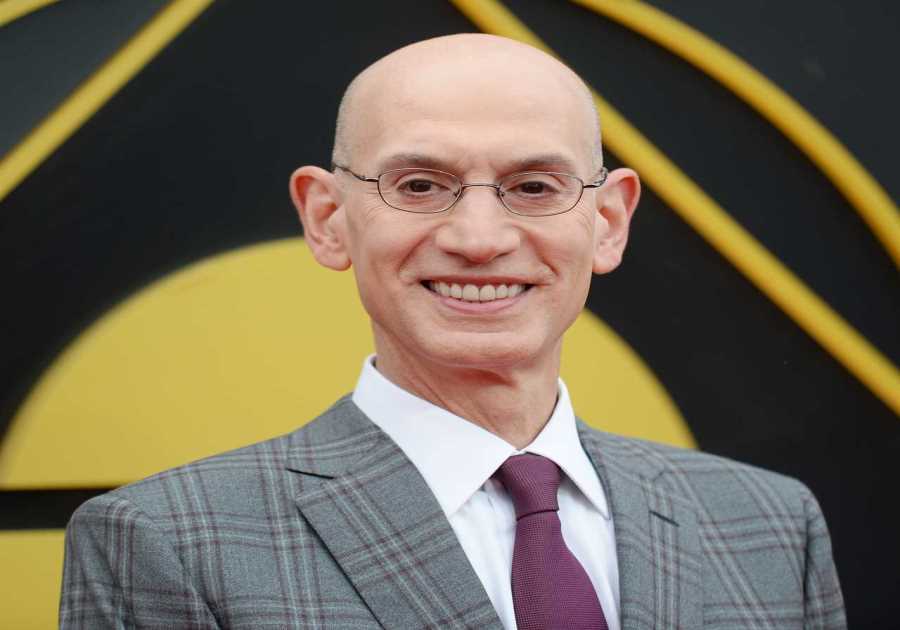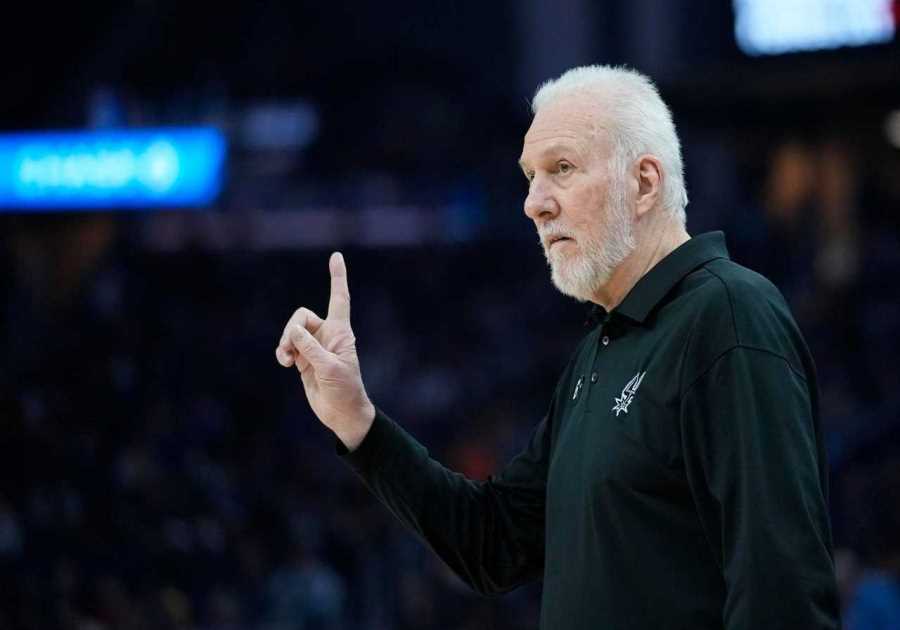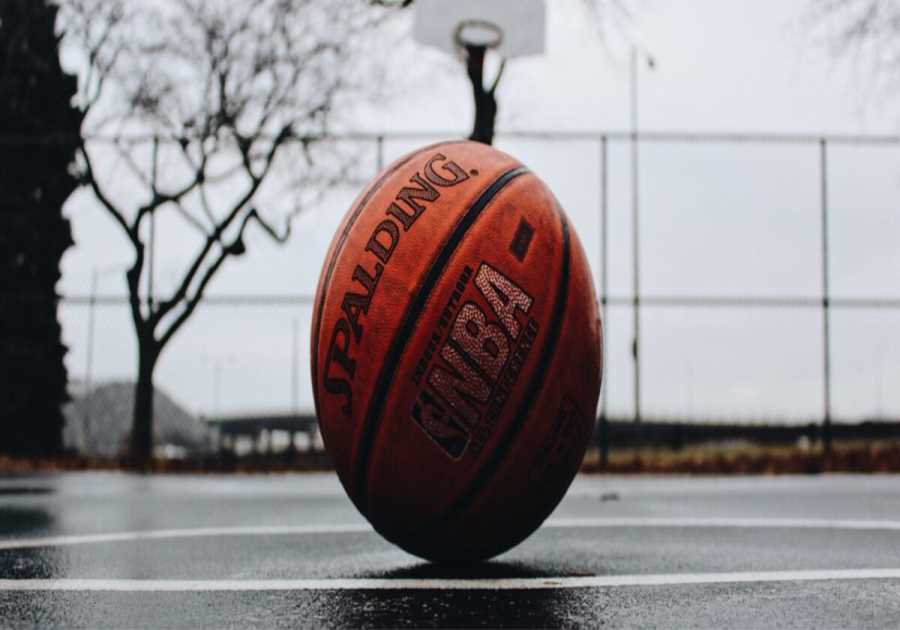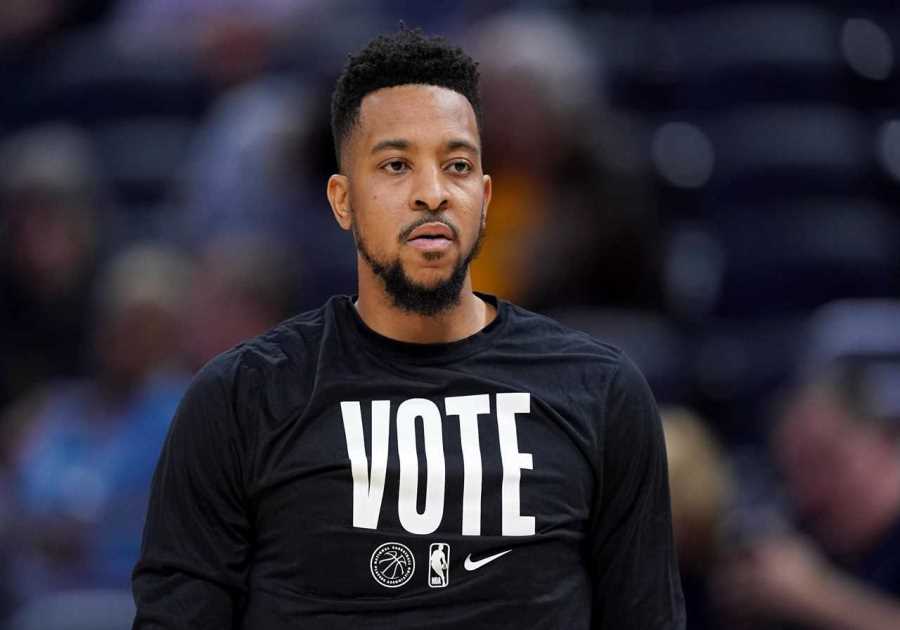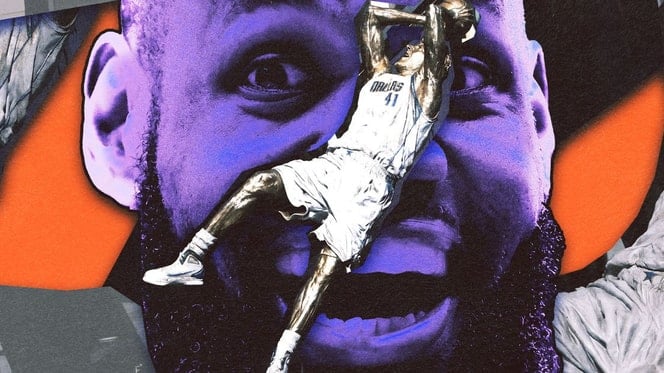
Every statue of an athlete is a contradiction. You can capture a player’s likeness and you can do justice to what they’ve achieved, but it’s impossible to fully render a career spent in motion with a sculpture. The challenge of immortalizing sporting legends is to try anyway—to give a still figure of a runner or pitcher or point guard so many of the markers of movement that it might trick the brain into thinking it’s seeing what it knows to be impossible. To suggest, for example, that the enormous statue of Dirk Nowitzki that now stands outside the American Airlines Center in Dallas could really be leaning back into a jumper, fading away so convincingly that you might even anticipate it landing in a soft backpedal.
“Like it’s a giant feather in the middle of the air, and not 1,500 pounds of bronze,” Omri Amrany, the sculptor behind the statue—and a great many in the NBA world—said by phone recently.
When Amrany—with his wife, Julie Rotblatt Amrany—designed the now-legendary statue of Michael Jordan that soars through the lobby of the United Center, he accentuated the perfect balance of the triangle that was always there in Jordan’s “Jumpman” pose. When he created a monument of Shaquille O’Neal that now dunks on a rim outside Crypto.com Arena, he wanted fans to be drawn in to look up at the statue from underneath it, and yet intimidated by the physical presence of Shaq, weighing a literal ton, hanging over their heads. In capturing Dirk, Amrany pushed the angle of Nowitzki’s signature fadeaway to a point that almost felt impossible.
“When it’s up there in the air, it takes away from the brain the feeling that this is a human being,” Amrany said. “It becomes like a flying object.”
Our Top 100 players, the most exciting guys to tune into on League Pass, and more
Depending on your angle, you can now see Nowitzki shoot over the top of high-rise apartment buildings, luxury hotels, and the most towering fixtures of the Dallas skyline. These sorts of monuments are a rare gesture—there are only about 16 true, full-body statues of NBA stars in the cities where they played—but Nowitzki had an exceptional career worthy of exceptional recognition. Beyond the revolutionary shooting, the open-and-shut Hall of Fame case, and the title Dirk brought to the city in 2011, he also holds a record that may never be broken: an entire, 21-season career spent with a single NBA team.
“Well,” Nowitzki said after the unveiling ceremony, “we hope Luka can break it.”
Many of the current Mavericks were in attendance when Dirk’s statue was unveiled on Christmas morning, among them 23-year-old megastar Luka Doncic—an all-too-worthy heir of the franchise player mantle. Doncic could be the best basketball player in the world someday, if he isn’t already. Like Dirk, he could be an MVP and a champion, and go down as one of the greatest to ever play the game. And yet the idea of Luka having his own statue at the end of his career seems to run contrary to the working reality of the league he plays in. Many of the NBA’s most decorated active players are already suiting up for their third or fourth teams. Today’s up-and-coming stars are as mobile and as untethered to any one franchise as any generation of players in league history. It’s only going to get more and more difficult to imagine an NBA player becoming a literal, physical part of a city’s architecture—to the point that we could be watching the last wave of statue subjects as we speak.
Every existing NBA monument was built on its own terms, but if we look at the players who have been honored thus far, we can see the criteria behind their selection begin to form:
1. Did the player achieve above and beyond Hall of Fame standards? Think of it this way: The overwhelming majority of the players on the NBA’s 75th Anniversary list—nominally the 75 (err, 76) greatest players in the history of the league—don’t have statues. It’s not enough to be great. The threshold for stonework and metallurgy is so much higher.
2. Is this one of the most significant players in the franchise’s history? Plenty of athletes have statues in their hometown or at their alma mater, but getting a monument outside an NBA arena requires outsized influence on a particular franchise. You simply cannot tell the story of the Mavericks without Dirk, or the Jazz without Karl Malone.
3. Does the player have a lasting and unique connection with the city itself? In almost every case, the NBA players who have had statues built in their honor played at least 12 seasons in the city where the statue was built. The notable exceptions are O’Neal (who played only eight seasons with the Lakers, but won three championships as the most dominant player on one of the best teams ever assembled) and George Mikan (who played only seven seasons in Minneapolis as a Laker and, despite over 30 years of Timberwolves basketball, hasn’t had much competition).
With that general framework, there are a few legends who are all but certain to get statues of their own. Tim Duncan would be a lock if he’s even interested in that sort of recognition—though he could also be honored alongside Gregg Popovich, Tony Parker, and Manu Ginobili at some later date, following Pop’s eventual retirement as head coach of the Spurs. Stephen Curry—one of the few players who could challenge Dirk’s record run with a single team—will be cast in bronze someday. The late Kobe Bryant already has two numbers retired by the Lakers and will inevitably get his own statue in Los Angeles, too. It’s more a matter of when than if for Bryant, and—given the dense mythology around him and the sheer number of iconic moments he was involved in—how exactly his statue might be posed.
“I think the jersey in the mouth—just the grit, the determination to win,” said Hall of Famer Jason Kidd, who played against Bryant in the 2002 NBA Finals and alongside him in the 2008 Olympics. “When you look at the Black Mamba, [it’s] just his ability to help his team or push his team to victory. I always thought the coolest thing is when he puts his jersey in his mouth and he was taking on the world.”
(When asked if he’s had any conversations with the Lakers about a statue for Bryant, Amrany—who was commissioned for the statues of O’Neal, Kareem Abdul-Jabbar, Magic Johnson, Jerry West, Elgin Baylor, and longtime broadcaster Chick Hearn—declined to comment.)
Bryant, Curry, and Duncan are all tidy cases, where statue-making is concerned—all-time greats who won titles and awards while spending their entire careers with a single team. Then the conversation breaks open, as it so often does, when we consider the legacy of LeBron James. When it was suggested to LeBron in a press conference last month that he would have his own statue someday, he projected humility. “I hope,” he said with a smile. “I hope. I hope.” He will. It would defy every precedent, expectation, and tenet of human logic for there not to be a sculpted tribute to LeBron installed somewhere in greater Cleveland. But it might not stop there; James could be the first player in league history to be honored with a statue from multiple NBA teams, in part due to the undeniable weight of his sprawling career. LeBron already has more All-NBA selections than anyone else. He’s won titles with three different franchises and MVPs with two. In a matter of weeks, he could edge out Abdul-Jabbar as the all-time leading scorer in the history of the league.
“I’ll always say Michael Jordan is the GOAT,” Nowitzki said. “But if [LeBron] really surpasses Kareem in the scoring record, I’m sort of running out of arguments for Michael.”
Would the Heat, a franchise that retired Jordan’s jersey despite him never even playing for the team, really choose not to physically commemorate the best player who actually did? Or would the Lakers, who have built statues for every superstar to lead the franchise to a championship thus far, really pass up the opportunity to recognize James in the same way? These sorts of questions are reckoning as much with LeBron’s accomplishments as they are the state of the NBA. James spent just four seasons with the Heat, and is currently playing his fifth with the Lakers. History says that’s not enough. But for a player who has already changed the league and the sport in so many ways, maybe that precedent is simply the next thing to go.
After all, a more extreme case may already be under consideration. In 2021, Warriors governor Joe Lacob told NBC Sports Bay Area that there was a running list of recent players whom the franchise would honor in some permanent way: Curry, of course; Draymond Green (whom Lacob all but promised a statue after his contract extension in 2019); Splash Brother Klay Thompson; Andre Iguodala, who would be a one-of-a-kind statue candidate in his own right; and mercenary superstar Kevin Durant, who spent just three seasons with the franchise but co-anchored what might be the greatest team the NBA has ever seen.
“I’d say those five guys certainly deserve some sort of ultimate, long-term recognition,” Lacob said two years ago. “And once they retire, I’m sure they will be appropriately honored.”
Durant has openly discussed the possibility of someday having his own statue outside the Chase Center, though he didn’t stay with the franchise long enough to suit up in that arena as a Warrior. The very idea of a Durant statue in San Francisco feels a bit strange—as a choice to honor something so fleeting with something so permanent. And that’s exactly what makes it the perfect test case for statue building in the modern era. Every monument is a reflection of its time. It didn’t really matter that Shaq’s tenure in Los Angeles was the shortest of any NBA legend to get the statue treatment. The 2001 Lakers were one of the best teams of all time because of him. You could say the same of Durant and the 2017 Warriors, and that fact alone creates an avenue for exceptions to be made.
After all, isn’t that what statues are for? Exceptional cases? Even if the standards for what merits a statue shift to reflect the realities of modern player movement, they’ll still be reserved for the kinds of athletes we’ve never seen before. It’s not enough—nor has it ever been—for a player to simply dominate. To be cast in bronze or cut from marble, they have to be part of something genuinely groundbreaking.
As odd as it would be for a statue of Durant to stand for decades where he played for only a few years, it might seem more odd for lesser players to get their own monuments while KD goes without. These sorts of statues always exist in conversation with one another; when a statue of Larry Bird was commissioned for the campus of Indiana State University, the artist specifically designed it to be taller than any statue of Magic Johnson. It takes more than greatness alone to deserve a statue, but how would it sit in the historical context of the game if, say, Kyle Lowry or Damian Lillard were immortalized in physical form, but Durant wasn’t?
Those outcomes are possible, if exceptional in their own way. Players are rarely honored with a statue if they’ve never won an MVP. Even fewer get one without ever winning a championship. The only statued players to never win either are John Stockton and Dominique Wilkins—who overcame that deficit through long, successful tenures with the Jazz and Hawks, respectively. Lillard could end up with a similar body of work, though the fact that he’s effectively had to go out of his way—amid trade rumors and flirtations with superteams—to remain a Blazer for a decade only illustrates how unusual that model has become.
Russell Westbrook could conceivably wind up with a statue in Oklahoma City, in no small part because he stayed when Durant didn’t. Maybe that’s the way it’s supposed to be. Modern superstars can hand-pick their city and their teammates, and become an organizational philosophy unto themselves. They can have everything they’ve ever wanted, but maybe they pay for it in bronze.
There is an inscription at the base of Nowitzki’s statue that reads: “LOYALTY NEVER FADES AWAY.” It’s a tribute to a star who stuck around—21 letters for Nowitzki’s 21 years as a Maverick, in what even the architects behind the statue admit is more of a happy accident than real intention. Mythology tends to work that way. Some of those 21 years were hard on Nowitzki, as he grappled with doubt in his early career, then with persistent frustration, and eventually with his own inevitable decline. Yet as a figure now frozen into the design of downtown Dallas, he represents something else—something that every statue of every NBA great represents in its own way.
“It all boils down to this part of humanity: to get up and keep going,” Amrany said. To endure.
Statues can’t help but smooth over the rougher edges of their subjects, reducing something as fickle as a person to an idea. It’s a timeless sort of myth-making that doesn’t really happen all that much in professional sports anymore. Today’s NBA players are hyper-visible, subject to constant judgment and referendum, and accessible to the point that they’ve been largely demystified. The league is as talented as it’s ever been, and yet it’s harder than ever to frame a contemporary star as a legend. As an icon. At this point, the idea of building something truly lasting in the NBA feels almost impossible.
“This is what makes a statue like that so special: that generations after us will see this after we’re long, long gone,” Nowitzki said. “People are gonna see the statue and Google—or maybe Google is already out by that point. But look it up. Who is this guy? What did this guy do? I think that’s what’s so cool about a statue and sculpture like this. It lives for eternity.”
Duncan, Kobe, and LeBron will live forever in the same way—as will Steph and the Warriors, and maybe Durant, too. If things continue apace, Giannis Antetokounmpo (who in 10 seasons with the Bucks has already won just about everything there is to win) could join them. The next wave of monument candidates beyond them will be different, because the league itself already is. We are living in a revolutionary era of NBA history that has redefined the culture of the sport, from what is expected of an all-time player to the nature of how a fan or a city connects to that player in the first place. If NBA teams are still building statues 20 years from now, those monuments will say something new.
“There’s always something else—something better coming down the line,” Nowitzki said. “So we’ve gotta appreciate that. The game never stops. It keeps evolving.”
Sign up for the
The Ringer Newsletter
Digg Editors
https://www.theringer.com/nba/2023/1/12/23550788/nba-statues-dirk-nowitzki-lebron-james
By: Digg Editors
Title: Does The NBA Have Any More Statue-Worthy Superstars?
Sourced From: www.theringer.com/nba/2023/1/12/23550788/nba-statues-dirk-nowitzki-lebron-james
Published Date: 01-12-2023
Frequently Asked Questions
Who invented basketball
While it isn't known exactly where basketball originated, it's widely believed that James Naismith (now Springfield College), was a teacher at the International Young Men's Christian Association's Training School (now Springfield College). Naismith established the basics of the game and then nailed a basket with peaches onto an elevated track. He formed nine teams from his 18-member class and began to teach them the basics. Original version had a soccer ball and two peach baskets attached to the gymnasium's ends. It was possible to shoot from the bottom of the basket; goaltending was not yet an aspect of the game. The game quickly spread throughout America and, by the 1900s was an organized sport with professional players playing in large arenas. Today, it is one of the most popular sports in the world.
How much are players paid in NBA?
The NBA's average salary for the 2021-2022 seasons is $7.3million. This figure is based on the maximum allowed salary cap of $134 million, which was set for this season. The individual salaries of players can vary depending on their accomplishments and experience.
Kevin Durant, LeBron James, and Kevin Durant are superstars that can earn upwards of $40,000,000 per year. Newcomers may only be able to make the minimum $898,310 salary. Other veteran players could be eligible for exception salaries that range from $4.76million to $9.258million, depending on how many years they have been playing. Players may also be eligible for bonuses and other incentives based on their performance or team success.
What is the greatest NBA Dynasty ever?
This hotly contested topic has been discussed for decades. The "showtime Lakers of 1980-1989" won five championships, led by Hall of Famer Magic Johnson and Kareem Abul-Jabbar. During this period, the Lakers featured stars such as James Worthy (Byron Scott), and Kurt Rambis.
From 200-2004, the Los Angeles Lakers, also known as Shaw and Kobe Lakers were a formidable force. They were defended by Shaquille and Kobe Bryant, both Hall of Famers. They won three consecutive championships from 2000 to 2002.
The Chicago Bulls in the 1990s were also a dominant force. They won six titles under Phil Jackson, their iconic head coach. Michael Jordan was the team's greatest player, widely regarded as one of the greatest ever. The Chico Bulls (1995-1996) are one of the most famous teams in NBA History. They won three consecutive NBA championships and had a record 72 wins. The Bulls' 1972-10 regular season record was broken in 2015-2016 by the Golden State Warriors.
The 1960s Boston Celtics were perhaps the most famous dynasty of the NBA. They won eight consecutive championships and eleven titles under Hall of Fame coach Red Auerbach. The Celtics, led by legend players such as Sam Jones and Bob Cousy, John Havlicek and John Cousy, created a winning culture that is unmatched for decades.
The San Antonio Spurs are another contender for the title of best NBA dynasty. The Spurs have won four championships since 1999 and enjoyed one of the most successful runs in NBA history. The team was led by future Hall of Famer Tim Duncan and Tony Parker, Manu Ginobili, and Gregg Popovich as their coach. They improved the team's basketball game, emphasizing a team-first mindset that helped them to be successful.
With four NBA championships over the past decade, the Golden State Warriors are one the most successful teams ever. Steve Kerr, Klay and Stephen Curry, as well as Klay, Klay, Thompson, are the Warriors' stars. The Warriors have a unique brand of basketball that has won over fans all over the world. They are also considered to be the greatest NBA dynasty.
The task of choosing the greatest NBA dynasty is not an easy one. Each team had its own group of players and coaches who made them successful. But some teams were more notable than others because they were dominant. It would be hard to argue for the greatest NBA dynasty without the Bulls Bulls Bulls Celtics Spurs Warriors and Celtics.
Which NBA player is the most successful in blocking shots?
Mark Eaton set the all-time records for blocks (456) and blocks per game (5.56) in a season during 1984-85. Eaton's total for that season is the highest single-season NBA record.
Hakeem Olajuwon holds the NBA's record for most career blocks at 3,830. Olajuwon was averaging 21.8 points per game, 11.1rebounds, 2.5 assists, and 3.0 blocks over his 18-year professional career.
What is an exception to the NBA trade policy?
The NBA offers a trade exception, which allows teams to trade away a player. This exception allows teams acquire players whose salary is higher than what they traded away. The exception is available to a team over multiple seasons. It does not count against their salary cap, luxury tax threshold, or other restrictions. Trade exceptions provide a way for teams not to have to trim their rosters or make changes to their roster composition. This allows for teams to compete and avoid situations in which some teams may have an unfair advantage because of their financial situation.
It helps the league stay financially stable and allows teams to make changes without worrying about not being able to pay. Trade exceptions are an integral part roster construction in NBA. They can be used to help teams fight for championships.
How much does a ref in the NBA make?
Referees in National Basketball Association (NBA), receive competitive salaries for their officiating responsibilities. An average NBA referee makes between $150,000 to $550,000 annually. The salary range is affected by referee experience. Referees with more experience earn higher salaries. Refs who work in the playoffs or Finals earn even higher salaries than referees who take on additional roles, such as training new refs or working in the video review center. A few NBA refs also earn royalties and endorsements for their work on television or other media outlets. A job as a referee in the NBA is highly lucrative. If one is willing and able to put in the effort, it can be a steady source of income.
NBA referees get a salary in addition to retirement and health plans. This helps referees sustain a healthy lifestyle as they officiate games and make important calls that can impact a game's outcome. Referees are often eligible for subsidized lodging, meals, and travel to away matches. This can provide additional peace of mind as referees work in pursuit of perfection on the court.
NBA referees receive a decent wage for their hardwork and dedication. This is especially true when they are responsible to enforce the rules in one of the most popular sports in world. Although the job is not easy, it's rewarding and offers referees the chance to make an impact in basketball.
Statistics
- Williams would 'likely' accept a deal worth $14-15M/year; Celtics are 'unlikely' to offer such a deal (HoopsHype) (bleacherreport.com)
- An estimated 800 million viewers watched the [105]2017–18 season. (en.wikipedia.org)
- The 2013–14 season opened with 92 international players on the opening night rosters, representing 39 countries and over 20% of the league. (en.wikipedia.org)
- "NBA first-round ratings drop 27 percent, 40 percent since 2017–18". (en.wikipedia.org)
- Williams would 'likely' accept a deal worth $14-15M/year; Celtics are 'unlikely' to offer such a deal (HoopsHype) (bleacherreport.com)
External Links
sports.yahoo.com
- Yahoo Mail, Weather, Search & Videos
- NBA Finals game 1 sees the lowest viewing in recorded ratings history
si.com
- NBA Free Agency Preview. The Biggest Question and Rumors
- Free from Quarantine: The NBA bubble Is A Unique Experience
bleacherreport.com
- Which NBA Teams will Join the Victor Wembanyama Teamathon?
- Latest NBA Intel: Sources Expect Zach LaVine to Re-Sign with Chicago Bulls
twitter.com
- Tweet / Twitter
- Sam Amico on Twitter: "Timberwolves Waive PJ Dozier, CJ Elleby and AJ Lawson - Hoops Wire https://t.co/xKu1ZTuQZN" / Twitter
How To
How an NBA Getty Images Photographer Captures Perfect Shots
This article will explain how a NBA Getty Images photojournalist can capture the perfect shot. First, you must choose the right location. Next, choose the best angle to take your photo. Finally, you must anticipate what might happen next.
- Step 1: Selecting a suitable location
Select the right time and the place where you want to take your photograph in order get the best result. If you have too many people around you, it is possible to lose the moment in case something happens during exposure. You also want to avoid having people blocking your view, so try to find a spot where they won't be able to see you taking pictures.
Once you have found a good spot for your camera, begin snapping away. It is always easier for you to move closer and not further back.
- Step2: Choose the Best Angle
After finding the best location, you need to consider the camera angle. This is the most important aspect of capturing a great photo.
You should choose a position that allows you to see the subject matter clearly without getting in the way. You can look through the basket hoops if you want to capture a basketball player performing a layup. That'll give you a nice, tight frame without obstructions.
Next, look for interesting angles. Try to find one that shows something unique about the athlete. While a low angle will show his height, a high angle will showcase his athleticism.
Finally, think about framing. Framing is how things are placed within a frame. The best composition is one that balances the foreground (what is closest to the lens) and the background (everything else).
- Step 3: Anticipating what might happen next
Think ahead. Be ready to act quickly if you see something strange, like a player diving into the lane, or a ball rolling toward he rim. You can quickly call "action" or cut.
You can freeze the scene when you hear those words. Wait for the action to resume, then move on. By freezing the scene, you ensure you'll have a sharp focus when you press the shutter button.
This guide will help you to get the perfect shot every time. With practice and patience, you'll be able to master your craft as an NBA Getty Images photographer and take stunning photos that will last a lifetime.

